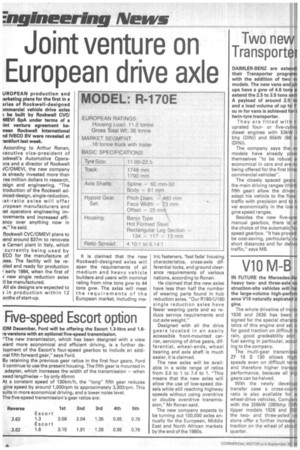European drive axle
Page 14

If you've noticed an error in this article please click here to report it so we can fix it.
UROPEAN production and arketing plans for the first in a Dries of Rockwell-designed Dmmercial vehicle drive axles
be built by Rockwell CVC/ MEVI SpA under terms of a lint venture agreement beveen Rockwell International rid IVECO BV were revealed at ran kfurt last week.
According to Arthur Ronan, Kecutive vice-president of pckwell's Automotive Opera)ns and a director of Rockwell JC/OMEVI, the new company gs already invested more than ree million dollars in research, ?sign and engineering. "The troduction of the Rockwell adtnced-design, single-reduction, ist-ratio axles will offer iropean manufacturers and ;et operators engineering im'ovements and increased effiency over anything now in ;e," he said.
Rockwell CVC/OMEVI plans to lend around $37m to renovate e Cameri plant in Italy, which currently being used by ECO for the manufacture of ises. The facility will be reoled and ready for production
early 1984, when the first of ( new single reduction axles II be manufactured.
All six designs are expected to ?. in production within 12 onths of start-up. It is claimed that the new Rockwell-designed axles will span the requirements of all medium and heavy vehicle builders and users with nominal rating from nine tons gvw to 44 tons gvw. The axles will meet the requirements of the European market, including me tric fasteners, 'fast fade' housing characteristics, cross-axle differential locks, and ground clearance requirements of various nations, according to Ronan.
He claimed that the new axles have less than half the number of wearing parts found in hub reduction axles. "Our R180/U180 single reduction axles have fewer wearing parts and so reduce service requirements and cut axle weight."
Designed with all the drive gears located in an easily accessible front-mounted carrier, servicing of drive gears, differential, wheel-ends, wheel bearing and axle shaft is much easier, it is claimed.
The new axles will be available in a wide range of ratios from 3.0 to 1 to 7.4 to 1. "This means that the new axles will allow the use of low-speed diesels while still reaching highway speeds without using overdrive or double overdrive transmission," Mr Ronan said.
The new company expects to be turning out 100,000 axles annually for the European, Middle East and North African markets by the end of the 1980s.












































